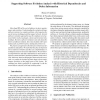192 search results - page 6 / 39 » Using History Information to Improve Design Flaws Detection |
LREC
2008
13 years 9 months ago
2008
Being the client's first interface, call centres worldwide contain a huge amount of information of all kind under the form of conversational speech. If accessible, this infor...
JSAC
2008
13 years 7 months ago
2008
Abstract-- We explore the performance and hardware complexity tradeoffs associated with performing iterative multipleinput multiple-output (MIMO) detection using a sphere decoder a...
SIGSOFT
2007
ACM
14 years 8 months ago
2007
ACM
Finding flaws in security protocol implementations is hard. Finding flaws in the implementations of sensor network security protocols is even harder because they are designed to p...
MSR
2005
ACM
14 years 1 months ago
2005
ACM
Refactoring is one means of improving the structure of existing software. Locations for the application of refactoring are often based on subjective perceptions such as ”bad sme...
ICSM
2008
IEEE
14 years 1 months ago
2008
IEEE
More than 90% of the cost of software is due to maintenance and evolution. Understanding the evolution of large software systems is a complex problem, which requires the use of va...

